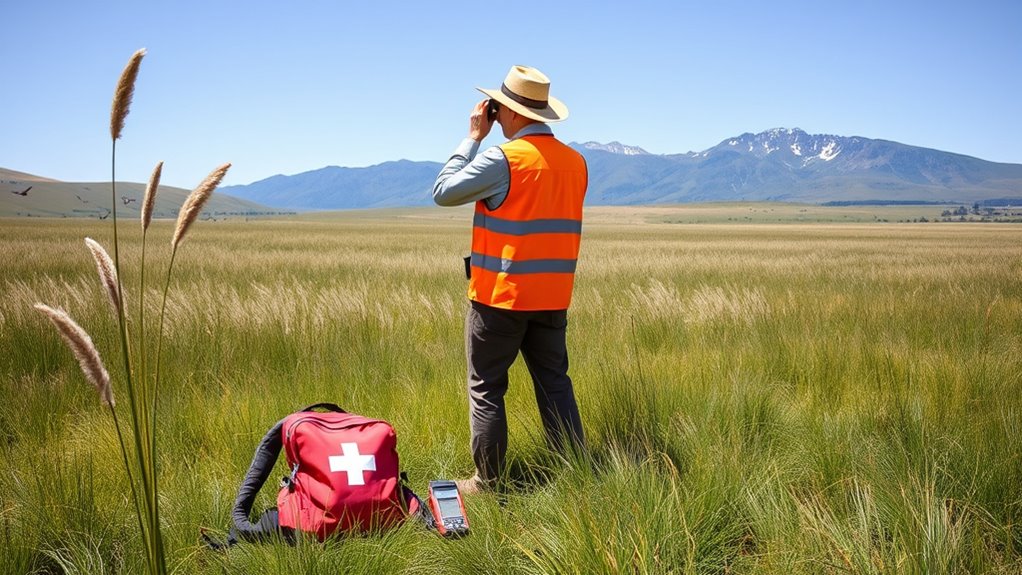To stay safe during wild field research, guarantee your gear is well-maintained and suited for the environment, and always share your itinerary with trusted contacts. Pay attention to weather updates, navigate using landmarks, and stay visible with bright clothing. Keep communication devices handy for emergencies, watch for wildlife signs, and respect animal habitats. Planning thoroughly and being prepared for unexpected situations help protect you. Continuing further will provide detailed tips to keep you secure in the wild.
Key Takeaways
- Prepare and inspect all equipment, maintain communication devices, and share your itinerary with trusted contacts.
- Stay updated on weather, use detailed maps, and identify landmarks to navigate safely in challenging terrains.
- Wear bright clothing, use clear signals, and carry a first aid kit to enhance visibility and emergency response.
- Observe animal signs respectfully, keep safe distances, and be aware of behaviors to prevent dangerous encounters.
- Conduct risk assessments, plan precautions, move quietly, and practice ethical observation to minimize hazards and disturbances.
Preparing Your Gear for Fieldwork
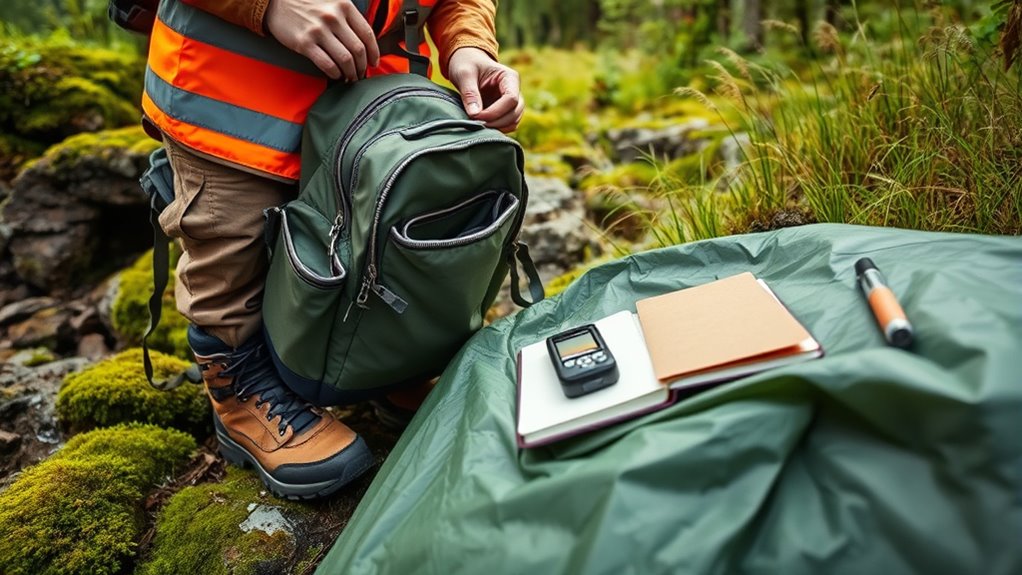
Properly preparing your gear is essential to guarantee safety and efficiency during fieldwork. Understanding wildlife behavior helps you select the right equipment and avoid startling animals. Before heading out, inspect all your gear for damage and ensure it functions properly—this is equipment maintenance in action. Properly maintained tools reduce the risk of malfunctions that could compromise safety. Pack essential items like binoculars, cameras, and safety gear, making sure they’re clean and operational. Don’t forget to bring backup batteries and protective cases. Familiarize yourself with your equipment to use it effectively in the field. Well-prepared gear not only keeps you safe but also allows you to observe wildlife behavior more effectively, making your research more accurate and efficient.
Understanding the Terrain and Weather Conditions
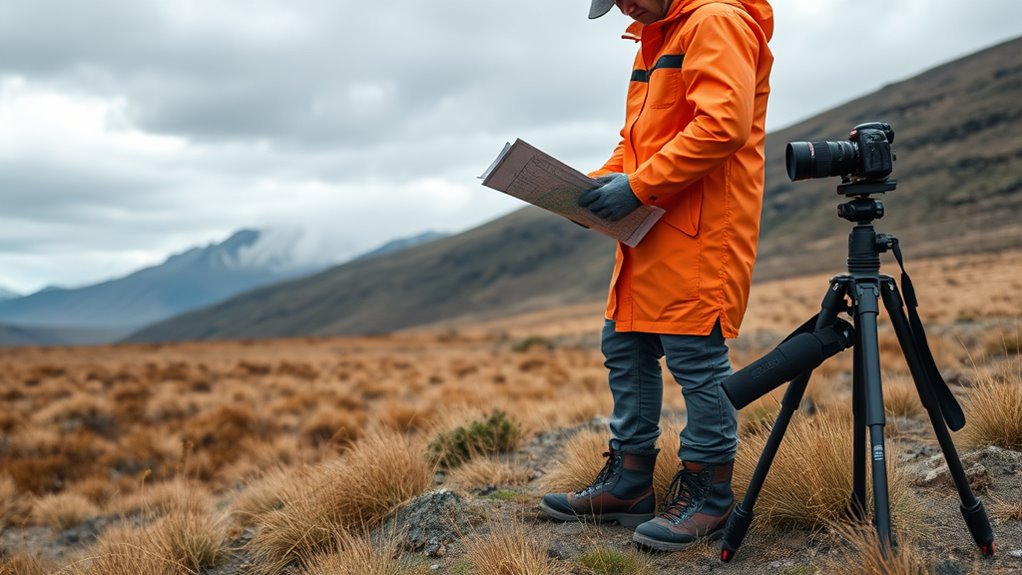
You need to stay aware of weather forecasts to avoid unexpected storms or temperature drops. Make sure you have a detailed map and understand the terrain to navigate safely. Proper preparation helps you adapt quickly to changing conditions and reduces risks during your fieldwork.
Weather Forecasts Matter
Understanding the terrain and weather conditions is crucial for ensuring safety during field research, especially when forecasts can change rapidly. Weather patterns can shift unexpectedly, so staying informed with timely forecast updates helps you anticipate potential hazards. Regularly check reliable sources for the latest weather information, as changes in wind, precipitation, or temperature can impact your plans. Pay attention to severe weather alerts and be prepared to adjust your schedule if needed. Knowing how weather evolves allows you to avoid dangerous situations like flash floods, storms, or extreme cold. Additionally, modern weather forecasting tools can provide accurate predictions that improve your planning and safety measures. By integrating current forecast updates into your planning, you can make smarter decisions on when to start, pause, or retreat, ultimately keeping you safer in the wild.
Map and Terrain Prep
Since terrain and weather conditions directly influence safety, thorough map and terrain preparation is essential before heading into the field. Review topographical maps to understand elevation changes, slopes, and water bodies. Identify key terrain features like ridges, valleys, and rocky areas that could impact your movement or safety. Familiarize yourself with natural landmarks to help with navigation and orientation. Check recent updates or satellite imagery for changes in terrain or obstacles. Understanding these details helps you anticipate risks, plan your route, and avoid hazardous areas. Remember, weather conditions can alter terrain features quickly, so factor in potential rain, snow, or wind. Proper prep ensures you’re equipped to handle the environment confidently and respond swiftly to any terrain challenges. Being aware of vetted information can further enhance your safety planning and decision-making in the field.
Staying Visible and Communicating Effectively
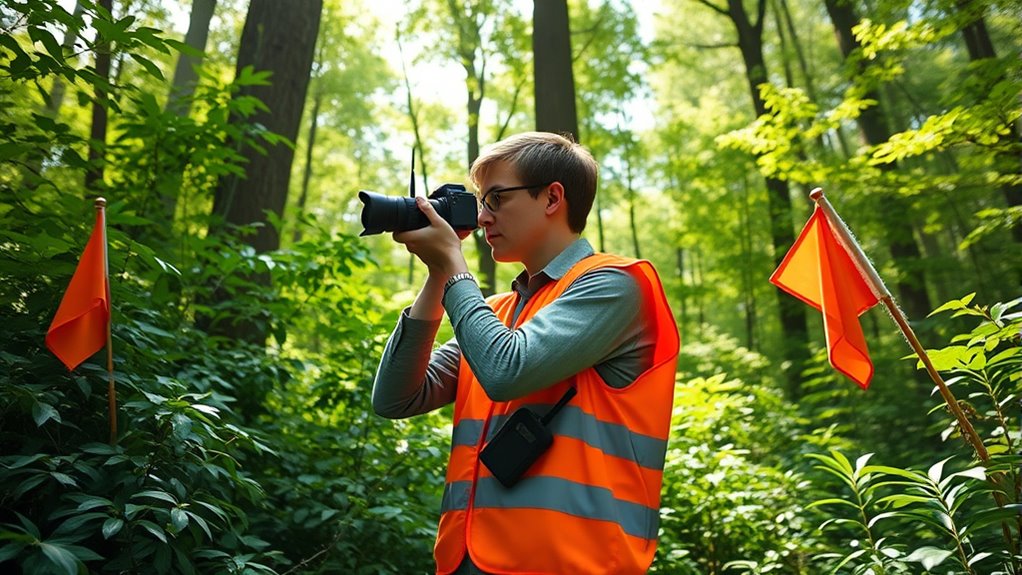
To stay safe in the field, you need to be clearly visible at all times. Wear bright clothing, use simple signals, and keep in regular contact with your team. These steps guarantee you can be found quickly if needed and communicate effectively throughout your research. Being aware of sustainable practices in the area can also help you anticipate and adapt to environmental conditions.
Wear Bright Clothing
Wearing bright clothing is essential for staying visible in outdoor field research environments. Bright safety clothing enhances color visibility, making it easier for colleagues and nearby individuals to spot you quickly. High-visibility vests, jackets, or shirts in vivid colors like orange, yellow, or lime green stand out amidst natural surroundings. This reduces the risk of accidents, especially in areas with moving vehicles or heavy machinery. Make sure your safety clothing is clean, well-maintained, and fits properly to maximize effectiveness. Bright clothing not only helps you stay safe but also signals your presence, facilitating smooth communication with team members. By prioritizing visibility through proper safety clothing, you create a safer, more aware fieldwork environment for everyone involved. Additionally, understanding the types of cookies used in digital environments can help you manage online privacy and security during your research activities.
Use Clear Signals
Using clear signals is crucial for maintaining visibility and ensuring effective communication during field research. Signal clarity helps others understand your intentions quickly, especially in noisy or distant environments. Use visual cues like hand signals, flags, or brightly colored objects to convey your messages clearly. Make sure your signals are simple, consistent, and easy to interpret. For example, raising your hand can signal “stop,” while waving a bright cloth indicates your location. Avoid ambiguous gestures that can be misunderstood. Proper use of visual cues keeps everyone on the same page and reduces the risk of accidents. Remember, clear signals enhance safety and help you stay connected with your team, even in challenging conditions. Effective communication through visual cues is essential for a successful and secure field research experience. Incorporating proper signaling techniques can further improve coordination and safety in the field.
Maintain Reliable Contact
Clear signals help keep your team informed and coordinated, but maintaining reliable contact goes beyond gestures alone. You should always have a working radio communication device to stay connected with team members and emergency contacts. Regular check-ins via radio ensure everyone’s safety and help quickly address issues that arise. Make sure your radio is charged, set to the correct frequency, and tested before heading out. Keep a list of emergency contacts handy, and inform them of your itinerary and expected check-in times. If radio communication isn’t feasible, establish alternative methods like satellite phones or signal mirrors. Proper radio maintenance and consistent communication are key to staying visible, alert, and prepared for any unexpected situations during your field research.
Recognizing and Avoiding Wildlife Encounters
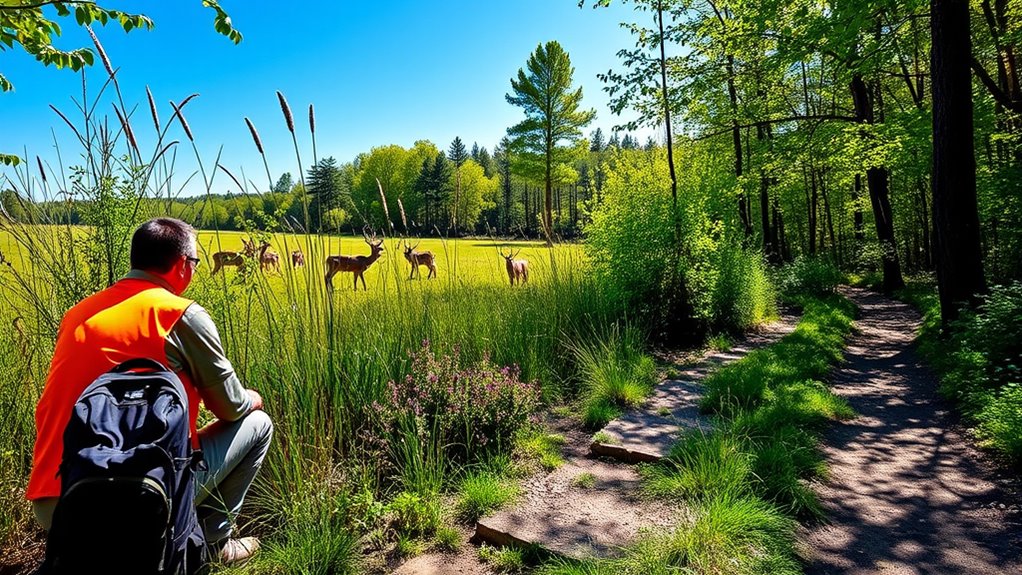
Being able to recognize wildlife signs and behaviors is essential for avoiding dangerous encounters during field research. By observing animal behavior carefully, you can identify signs of nearby wildlife, such as tracks, droppings, or vocalizations. Wildlife tracking helps you determine an animal’s presence and movement patterns, allowing you to maintain a safe distance. Look for fresh tracks or disturbed vegetation, which indicate recent activity. Stay alert to sudden movements or sounds that suggest an animal is nearby. Avoid approaching or startling wildlife, especially if they display defensive behaviors like growling or raised fur. Keeping a respectful distance and remaining aware of wildlife signs reduces the risk of surprise encounters, ensuring your safety as you observe nature responsibly. Additionally, understanding animal behaviors can provide insight into how to respond appropriately and avoid escalation.
Navigating Emergency Situations and First Aid
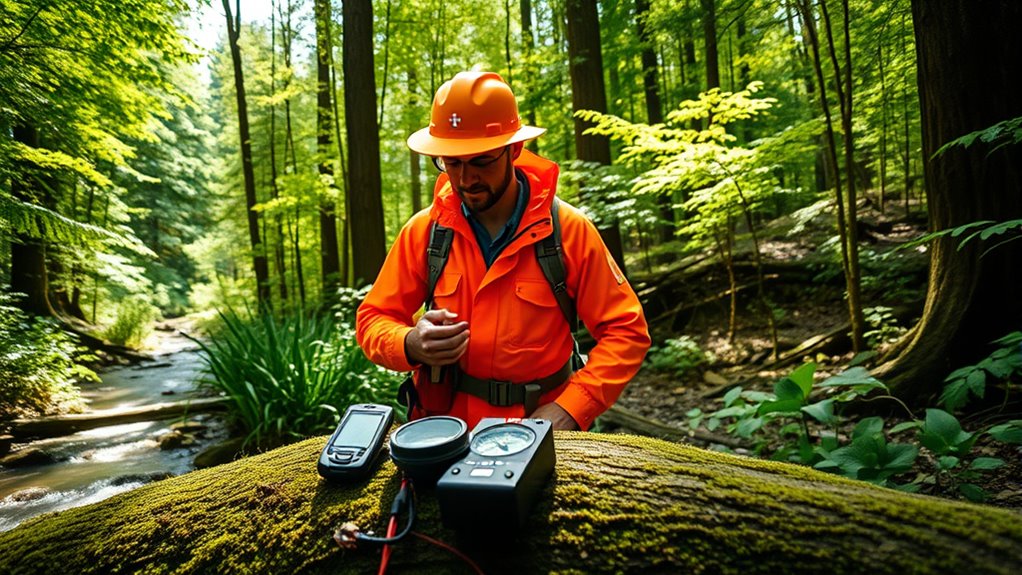
When an emergency occurs in the field, quick and confident action can make all the difference. Your emergency preparedness is vital—know the signs of potential issues and have a clear plan. Carry a well-stocked first aid kit with essentials like bandages, antiseptic wipes, and pain relievers. Stay calm, assess the situation, and prioritize safety. If someone is injured, provide basic first aid, such as stopping bleeding or immobilizing a fracture, while waiting for professional help. Familiarize yourself with first aid procedures beforehand so you can act swiftly. Remember, staying composed and knowing your first aid essentials helps prevent complications and keeps everyone safe until help arrives. Practicing first aid techniques can boost your confidence in emergency situations. Preparedness and quick response save lives in the wild.
Practicing Ethical and Responsible Observation
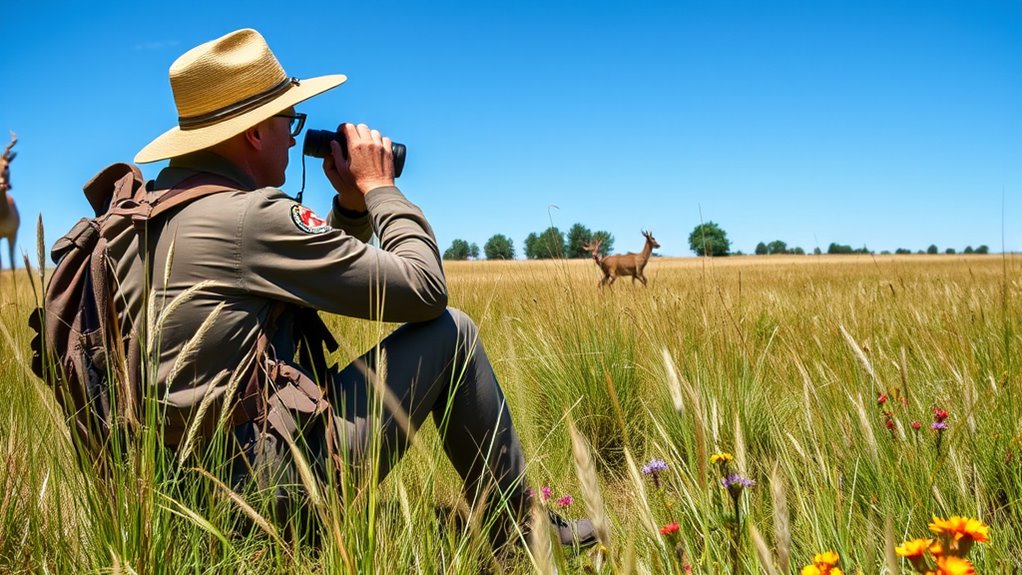
After ensuring safety and responding effectively to emergencies, it’s important to focus on observing your environment responsibly. When engaging in wildlife observation, always respect animals’ natural behaviors and habitats, avoiding any disturbance or stress. Practice ethical photography by maintaining a safe distance, using zoom lenses, and refraining from baiting or manipulating animals for a better shot. Be mindful of your presence; move quietly and avoid loud noises that could scare wildlife away. Remember, your goal is to observe and document without causing harm or altering the environment. Using appropriate equipment can enhance your observation experience while minimizing disturbance. By adhering to these principles, you guarantee your research remains respectful and sustainable, fostering trust with local communities and protecting the integrity of your fieldwork. Ethical observation benefits both the wildlife and your research outcomes.
Planning and Sharing Your Fieldwork Itinerary

Effective planning and sharing of your fieldwork itinerary are essential for ensuring safety, organization, and collaboration. Begin with a thorough risk assessment to identify potential hazards and determine necessary precautions. Once you’ve mapped out your route, clearly communicate your itinerary to colleagues, supervisors, or emergency contacts. Include details such as locations, estimated times, and expected activities. Sharing your itinerary ensures others know where you’ll be and when, facilitating prompt assistance if needed. Keep your itinerary flexible enough to accommodate changes, and update it regularly when circumstances shift. Remember, transparent itinerary communication not only enhances safety but also supports coordination with your team, making sure everyone stays informed and prepared throughout your fieldwork.
Frequently Asked Questions
How Do I Handle Unexpected Dangerous Encounters With Humans in Remote Areas?
When you face unexpected dangerous encounters with humans in remote areas, prioritize your personal safety by remaining calm and avoiding confrontation. Use conflict de escalation techniques, such as speaking softly and maintaining a non-threatening posture. If possible, slowly back away and create distance. Always carry a communication device for emergencies, and have a plan to reach help. Staying alert and respecting local customs also helps prevent conflicts and guarantees your safety.
What Are the Best Practices for Securing Sensitive Data Collected During Fieldwork?
Imagine your data is a treasure chest; securing it is vital. You should use data encryption to protect sensitive information from unauthorized access, even if your device gets lost or stolen. Implement strict access control, ensuring only trusted team members can view or modify data. Regularly back up files securely, and keep software updated to patch vulnerabilities. These practices safeguard your research and maintain the integrity of your findings.
How Can I Protect Myself From Insect-Borne Diseases During Outdoor Research?
To protect yourself from insect-borne diseases during outdoor research, prioritize insect protection by wearing long sleeves, pants, and treating clothing with permethrin. Use EPA-approved insect repellent containing DEET or picaridin, especially during peak insect activity. Avoid standing water and dusk or dawn hours when insects are most active. Regularly check for bites, and consider vaccination or prophylactic medication when advised, ensuring effective disease prevention.
What Legal Permits or Permissions Are Necessary for Conducting Field Research?
Guiding the world of research permits and ethical approvals is like finding a steady rhythm in your workflow. You’ll need to secure the appropriate research permits from local authorities and obtain ethical approvals from your institution’s review board. These steps ensure your work aligns with legal standards and ethical guidelines. By doing so, you demonstrate respect for regulations and the environment, paving the way for smooth and responsible field research.
How Do I Manage Mental Health and Stress During Prolonged Field Studies?
Managing mental health and stress during prolonged field studies is vital. You should practice mindfulness techniques daily to stay grounded and reduce anxiety. Reach out to peer support networks regularly, sharing your experiences and feelings. Remember, taking breaks and maintaining a healthy routine helps prevent burnout. Prioritizing self-care allows you to stay resilient and focused, ensuring your well-being while you gather valuable data in challenging environments.
Conclusion
As you venture into the wild, remember that your safety blossoms from careful preparation and respectful awareness. Think of your gear as a sturdy shield and your mindset as a gentle compass guiding you through unseen paths. By staying vigilant and considerate, you create a harmonious dance with nature’s delicate balance. With each mindful step, you paint a vivid picture of stewardship, ensuring your journey remains a safe and enriching story shared with the world.
